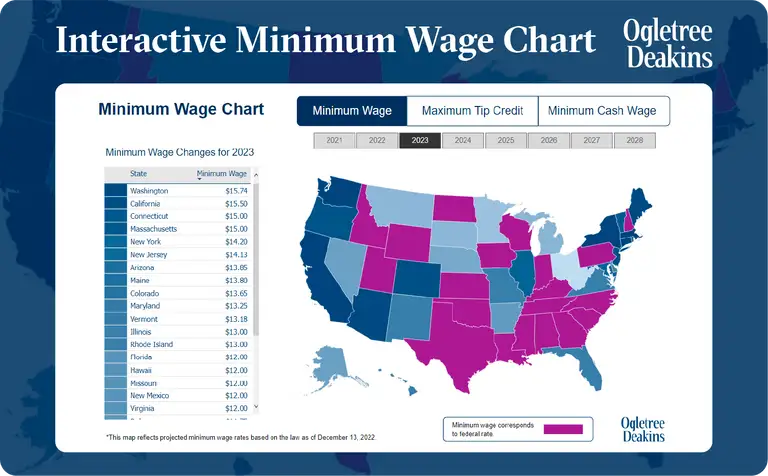Minimum wages are defined as being the minimum amount an employer can pay a wage earner.
This minimum, per-hour wage cannot be reduced by individual contracts or collective agreements.
If wondering which states increased minimum wages you're not alone; most employment seekers inquire this online which is why the Federal Minimum Wage became a trending search nationwide.
What is the minimum wage in the United States?
The minimum wage is the lowest allowed employee pay rate, it varies state-to-state and sometimes by city too. Federal minimum wage laws determine the acceptable wage and overtime pay rates workers receive while controlling exemptions for both as well. Minimum-wage jobs typically require workers to be serving or interacting with customers during shifts while offering no employee benefits or incentives.
Whether you're a business owner or human resources professional needing to learn federal regulations for compliance purposes, or if you're an employment seeker in search of minimum wage rates to see the states in which you can earn the most, this guide will prove useful to you.

Currently, the federal minimum wage for non-exempt employees is set to $7.25 per hour.
Aside from the federal minimum wage, all states have minimum wage laws of their own, and in some cases, the minimum wage in a city may differ from that of the states. If you are a business owner in a location having multiple minimum wage laws, you are required to pay employees the highest of those rates.
Minimum wages are purposed to protect employees from unduly low pay; they ensure a fair, equitable share of the fruits to those working to bear them. They ensure that minimum wage workers have a good quality of life, health insurance, as well as automatic increases as time passes by.
Minimum wages are also an element of a policy put in place to help overcome poverty and to combat inequality. Minimum wage rates were also enforced to defeat inequality between men and women and to give the right to equal remuneration for jobs of equal value.
Federal minimum wage history

The federal minimum wage history is an unfolding of events that makes for an interesting tale.
Despite it costing twenty percent more to live now than it did a decade ago, the federal minimum wage hasn’t risen in eleven years.
This has made it hard for low-wage workers to make ends meet, especially during a pandemic-induced, economic crisis. The minimum wage requirement pertains to both hourly wages and full-time job rates.
For the purpose of this guide, we extensively reviewed the minimum wage history, the controversies surrounding it, and the odds of us seeing a wage-rate increase from Washington elites.
For a better understanding, let's take a quick historical deep dive.
It was June 25, 1938, when the president, Franklin Roosevelt, sat in the Oval Office waiting to sign the 120 bills scattering the desk before him.
One of these bills was legislation that would forever change the course of American labor; the Fair Labor Standards Act.
When first created, the Fair Labor Standards Act only applied to businesses engaging in interstate commerce. At the time, it only affected twenty percent of America's workforce, but it achieved equality and equal rights pay for the nationwide labor force as a whole; it outlawed child labor, set the maximum number of hours an employee can work to forty-four hours per week, and put a figure on the minimum wage an employee can earn.
There was a similar law in 1935 though it was quickly struck down by the Supreme Court. It was only two years later when the Court changed its mind and reversed its decision; they submitted a new bill through Congress to raise the federal minimum wage to forty cents per hour, which was opposed by small manufacturers declaring they couldn't afford it.
Believing some progress was better than none at all; Roosevelt compromised and set the federal minimum wage to twenty-five cents per hour for the first year of the bill’s enactment.
At this stage of his administration, Roosevelt had grown immune to cries of outrage from opponents, so he made the choice favoring American's over disgruntled manufacturers. The night before his signing of the bill, he gave the nation a speech, in it, he told Americans to not allow "calamity-howling" executives earning a thousand dollars per day to tell them their weekly pay of eleven dollars will have disastrous economic effects.
The very next year, the federal minimum wage was increased yet again, this time by a nickel; bringing it to thirty cents. The next raise was in 1945 when inflation finally caught up with increased money supply in circulation due to the first and second World War; hourly minimum wage rates rose to forty cents.
Ever since then, minimum wages have been periodically increased to reflect inflation and the ever-rising cost of living. However, successive congresses carried different viewpoints and ideas for what minimum wage laws stood for.
Ultimately, this led to inaction, which caused the minimum wage, to this very day, to perpetually fall short of keeping pace with inflation.
Minimum Wage Increment in 2021 [State Wise]
To ensure your business is currently on the latest minimum wage rates, or to see what rates currently are and will be in your area, this section will shed light on the matter. Regarding the subject matter, Minimum Wage by State has become a popular query amongst organizations and employment seekers, let’s get to it.
In 2021, twenty-one states will increase minimum wage rates, these states include:
1. Alaska
Alaska participates in the annual indexing increase which is based on the Consumer Price Index; the new rate for 2020 is $10.19. This will not affect employees receiving tips.
2. Arizona
In 2016, Arizona passed Proposition 206 which required the state's minimum wage to increase to $12.00 in 2020. The minimum wage for employees receiving tips is $9.00.
3. Arkansas
In 2018, voters passed Proposition 206, this proposition raised the minimum wage to $10.00 in 2020, although, tipped employees receive the same minimum wage; $2.63 per hour.
4. California
California's minimum wage rates vary between large and small employees. In 2020, small employers with twenty-five or less employees are subject to the $12 per hour minimum wage rate; those with twenty-six or more employees must pay wage earners $13 per hour.
Since there's no minimum wage rate for employees that receive tips, they must be compensated at the same rate. In 2022, state legislators are planning to increase the California minimum wage to $15.
As of July 1st, 2020, the following cities have increased minimum wage rates:
- Berkeley: $16.07
- Milpitas: $15.40
- Los Angeles: $14.25
- San Francisco City and County: $16.07
5. Colorado
Colorado has increased the minimum wage to $12.00 while tipped-employee rates increased to $8.98.
6. Connecticut
On September 1st, 2020, Connecticut's minimum wage rose to $12, although, the state plans to raise this to $15 in the coming few years.
7. Florida
Florida correlated its minimum wage to 2019's annual index rate. This meant Florida residents saw a minimum wage increase to $8.56 in 2020 while increasing to $5 for tipped employees.
8. Illinois
On January 1st, 2020, Illinois is receiving its first minimum wage increase since 2020, the new was $9.25.
However, on July 1st, 2020, the minimum wage increased again, this time, to $10.00 with minimum wages rising to $5.55 for tipped employees. Plans are currently in place to raise the minimum wage for non-tipped employees to $15 by 2025.
9. Maine
Minimum wages increase to $12 while tipped employees receiving $6.00.
10. Maryland
The minimum wage in Maryland increase to $11.00 in 2020 but the minimum wage for tipped employees did not; it's still $3.63.
11. Massachusetts
Massachusetts legislators are planning to raise the minimum wage in 2023 to $15. The new rate is $12.75 while the minimum wage for tipped employees increased to $4.95.
12. Michigan
Michigan wage earners saw a small raise to minimum wages during 2020, currently, it’s $9.65 and $3.65 for tipped workers.
13. Minnesota
Minnesota has varying minimum wage rates for place based on the size of employers. Instead of determining the minimum wage by the number of employees a business has (as California does), it's determined by the volume of business (annual revenue) the business generates.
For employers with over $500,000 per year in gross receipts, the minimum wage has risen to $10.00. If under that annual-sale amount, the rate is $8.15.
Tipped employees receive the same rates; all workers are compensated equally.
14. Missouri
Voters in Missouri passed Proposition B, also known as the $12 Minimum Wage Initiative. This stipulated that standard minimum wage rates be increased to $12 by 2023. Currently, the new rate is $9.45 while $4.73 for tipped employees.
15. Montana
Much like Minnesota, Montana gauges a business based on annual gross revenue instead of their employee count. Businesses generating $110,000 or more per year must pay employees $8.65 per hour, if under that amount the minimum hourly rate is $8.65. Tipped employees receive the same amount.
16. Nevada
On July 1st, 2020, Nevada's Assembly Bill 456 raised the minimum wage to $9 for employees not receiving benefits; $8 for those that do. Tipped employees receive the same rates.
17. New Jersey
New Jersey will increase the minimum wage by $1 each year. This amount could be more or less and is determined by the CPI, whichever is more.
Most employers were subjected to a minimum wage rate of $11 in 2020, though seasonal employers and ones with less than six employees are required to pay $10.30. Agricultural employers must pay employees a minimum of $10.30 per hour.
The minimum wage for tipped employees increased to $3.13.
18. New Mexico
New Mexico raised its minimum wage to $9.00 in 2020, the rate for tipped employees increased to $2.35. By 2023, these rates will increase to $9 and $3 respectively.
19. New York
New York increased its minimum wage to $11.80 in 2020. Employers are permitted to take a tip credit though tipped employees must be receiving the standard minimum wage rate.
20. Ohio
Ohio has varying rates for employers based on annual sales. The rate has risen to $8.70 for employers grossing $319,000 or more annually; $7.25 for employers earning less. The minimum wage for tipped employees rose to $4.35
21. Oregon
Oregon is planning to increase the minimum wage until 2023 and continuing to increase it based on the annual CPI. On July 1st, 2020, Oregon's minimum wage rose to $12, they must be paid the standard minimum wage.
22. South Dakota
Due to annual adjustment based on the CPI, South Dakota raised its minimum wage to $9.30. The minimum wage for those receiving tips is $5.48.
23. Washington
Due to a ballot initiative passed in 2016, Washington's minimum wage is now $13.50. There's no separate rate in place for wage earners receiving tips; they must receive the same amount.
States not listed above have not raised minimum wages though some have legislations in progress that would increase them.
24. Washington DC
On July 1st, 2020, Washington DC's minimum wage rose to $12; tipped employee’s rates increased to $5.
Here is the minimum wage for those that have not increased:
- Alabama: $7.25, $2.13 tipped minimum wage
- Delaware: $8.75, $2.23 tipped minimum wage
- Georgia: $7.25 standard minimum wage, $2.23 tipped minimum wage
- Hawaii: $10.10, $10.10 tipped minimum wage
- Idaho: $7.25, $3.35 tipped minimum wage
- Indiana: $7.25, $2.13 tipped minimum wage
- Iowa: $7.25, $4.35 tipped minimum wage
- Kansas: $7.25, $2.13 tipped minimum wage
- Kentucky: $7.25, $2.13 tipped minimum wage
- Louisiana: $7.25, $2.13 tipped minimum wage
- Mississippi: $7.25, $2.13 tipped minimum wage
- Nebraska: $9.00, $2.13 tipped minimum wage
- New Hampshire: $7.25, $3.26 tipped minimum wag
- North Carolina: $7.25, $2.13 tipped minimum wage
- North Dakota: $7.25, $4.86 tipped minimum wage
- Oklahoma: $7.25, $2.13 tipped minimum wage
- Pennsylvania: $7.25, $2.83 tipped minimum wage
- Rhode Island: $10.50, $3.89 tipped minimum wage
- South Carolina: $7.25, $2.13 tipped minimum wage
- Tennessee: $7.25, $2.13 tipped minimum wage
- Texas: $7.25, $2.13 tipped minimum wage
- Utah: $7.25, $2.13 tipped minimum wage
- Virginia: $7.25, $2.13 tipped minimum wage
- West Virginia: $8.75, $6.13 tipped minimum wage
- Wisconsin: $7.25, $2.33 tipped minimum wage
- Wyoming: $7.25, $2.13 tipped minimum wage
Final thoughts about minimum wage
Keep in mind, that while your state has a minimum wage of its own, the city in which you reside may have one of its own too. In the case of a business owner, this means you must follow the rates of the municipality in which you operate your business, not that of the states.
We hope this guide served you well, while minimum wage raises may have not occurred in your state this past year, many of these regions are planning increases in the coming few years, continue reviewing your state’s initiatives to do so and we’re anticipating many to follow suit of the state’s that have been actively raising rates these past few years.








